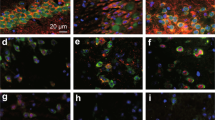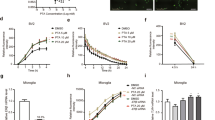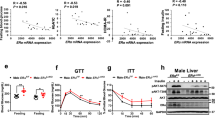Abstract
In the last decade of the twentieth century, two nuclear receptors were discovered in our laboratory and, very surprisingly, were found to have key roles in the central nervous system. These receptors have provided some novel insights into the etiology and progression of neurodegenerative diseases and anxiety disorders. The two receptors are estrogen receptor beta (ERβ) and liver X receptor beta (LXRβ). Both ERβ and LXRβ have potent anti-inflammatory activities and, in addition, LXRβ is involved in the genesis of dopaminergic neurons during development and protection of these neurons against neurodegeneration in adult life. ERβ is involved in migration of cortical neurons and calretinin-positive GABAergic interneurons during development and maintenance of serotonergic neurons in adults. Both receptors are present in magnocellular neurons of the hypothalamic preoptic area including those expressing vasopressin and oxytocin. As both ERβ and LXRβ are ligand-activated transcription factors, their ligands hold great potential in the treatment of diseases of the CNS.
This is a preview of subscription content, access via your institution
Access options
Subscribe to this journal
Receive 12 print issues and online access
$259.00 per year
only $21.58 per issue
Buy this article
- Purchase on Springer Link
- Instant access to full article PDF
Prices may be subject to local taxes which are calculated during checkout



Similar content being viewed by others
References
Harris HA, Albert LM, Leathurby Y, Malamas MS, Mewshaw RE, Miller CP et al. Evaluation of an estrogen receptor-beta agonist in animal models of human disease. Endocrinology 2003; 144: 4241–4249.
Spence RD, Voskuhl RR . Neuroprotective effects of estrogens and androgens in CNS inflammation and neurodegeneration. Front Neuroendocrinol 2012; 33: 105–115.
Im SS, Osborne TF . Liver x receptors in atherosclerosis and inflammation. Circ Res 2011; 108: 996–1001.
Sacchetti P, Sousa KM, Hall AC, Liste I, Steffensen KR, Theofilopoulos S et al. Liver X receptors and oxysterols promote ventral midbrain neurogenesis in vivo and in human embryonic stem cells. Cell Stem Cell 2009; 5: 409–419.
Kim HJ, Fan X, Gabbi C, Yakimchuk K, Parini P, Warner M et al. Liver X receptor beta (LXRbeta): a link between beta-sitosterol and amyotrophic lateral sclerosis-Parkinson’s dementia. Proc Natl Acad Sci USA 2008; 105: 2094–2099.
Wang L, Andersson S, Warner M, Gustafsson JA . Estrogen receptor (ER) beta knockout mice reveal a role for ERbeta in migration of cortical neurons in the developing brain. Proc Natl Acad Sci USA 2003; 100: 703–708.
Fan X, Warner M, Gustafsson JA . Estrogen receptor beta expression in the embryonic brain regulates development of calretinin-immunoreactive GABAergic interneurons. Proc Natl Acad Sci USA. 2006; 103: 19338–19343.
Suzuki H, Barros RP, Sugiyama N, Krishnan V, Yaden BC, Kim HJ et al. Involvement of estrogen receptor β in maintenance of serotonergic neurons of the dorsal raphe. Mol Psychiatry 2013; 18: 674–680.
Osterlund M, Kuiper GG, Gustafsson JA, Hurd YL . Differential distribution and regulation of estrogen receptor-alpha and -beta mRNA within the female rat brain. Brain Res Mol Brain Res 1998; 54: 175–180.
Grassi D, Amorim MA, Garcia-Segura LM, Panzica G . Estrogen receptor alpha is involved in the estrogenic regulation of arginine vasopressin immunoreactivity in the supraoptic and paraventricular nuclei of ovariectomized rats. Neurosci Lett 2010; 474: 135–139.
Suzuki S, Handa RJ . Estrogen receptor-beta, but not estrogen receptor-alpha, is expressed in prolactin neurons of the female rat paraventricular and supraoptic nuclei: comparison with other neuropeptides. J Comp Neurol 2005; 484: 28–42.
Kuiper GG, Enmark E, Pelto-Huikko M, Nilsson S, Gustafsson JA . Cloning of a novel receptor expressed in rat prostate and ovary. Proc Natl Acad Sci USA 1996; 93: 5925–5930.
Enmark E, Pelto-Huikko M, Grandien K, Lagercrantz S, Lagercrantz J, Fried G et al. Human estrogen receptor beta-gene structure, chromosomal localization, and expression pattern. J Clin Endocrinol Metab 1997; 82: 4258–4265.
Dunbier AK, Anderson H, Ghazoui Z, Lopez-Knowles E, Pancholi S, Ribas R et al. ESR1 is co-expressed with closely adjacent uncharacterised genes spanning a breast cancer susceptibility locus at 6q25.1. PLoS Genet 2011; 7: e1001382.
Tyulmenkov VV, Jernigan SC, Klinge CM . Comparison of transcriptional synergy of estrogen receptors alpha and beta from multiple tandem estrogen response elements. Mol Cell Endocrinol 2000; 165: 151–161.
Khalaj AJ, Yoon J, Nakai J, Winchester Z, Moore SM, Yoo T et al. Estrogen receptor (ER) β expression in oligodendrocytes is required for attenuation of clinical disease by an ERβ ligand. Proc Natl Acad Sci USA 2013; 110: 19125–19130.
Xue B, Zhang Z, Beltz TG, Johnson RF, Guo F, Hay M et al. Estrogen receptor-β in the paraventricular nucleus and rostroventrolateral medulla plays an essential protective role in aldosterone/salt-induced hypertension in female rats. Hypertension 2013; 61: 1255–1262.
Spence RD, Wisdom AJ, Cao Y, Hill HM, Mongerson CR, Stapornkul B et al. Estrogen mediates neuroprotection and anti-inflammatory effects during EAE through ERα signaling on astrocytes but not through ERβ signaling on astrocytes or neurons. J Neurosci 2013; 33: 10924–10933.
Nomura M, Akama KT, Alves SE, Korach KS, Gustafsson JA, Pfaff DW et al. Differential distribution of estrogen receptor (ER)-alpha and ER-beta in the midbrain raphe nuclei and periaqueductal gray in male mouse: Predominant role of ER-beta in midbrain serotonergic systems. Neuroscience 2005; 130: 45–56.
Cardona-Rossinyol A, Mir M, Caraballo-Miralles V, Lladó J, Olmos G . Neuroprotective effects of estradiol on motoneurons in a model of rat spinal cord embryonic explants. In motor neurons 17βE2 activates, the Akt anti-apoptotic signaling pathway and two of their downstream effectors: GSK-3β and Bcl-2. Cell Mol Neurobiol 2013; 33: 421–432.
Paech K, Webb P, Kuiper GG, Nilsson S, Gustafsson J, Kushner PJ et al. Differential ligand activation of estrogen receptors ERalpha and ERbeta at AP1 sites. Science 1997; 277: 1508–1510.
Teboul M, Enmark E, Li Q, Wikström AC, Pelto-Huikko M, Gustafsson JA . OR-1, a member of the nuclear receptor superfamily that interacts with the 9-cis-retinoic acid receptor. Proc Natl Acad Sci USA. 1995; 92: 2096–2100.
Willy PJ, Umesono K, Ong ES, Evans RM, Heyman RA, Mangelsdorf DJ . LXR, a nuclear receptor that defines a distinct retinoid response pathway. Genes Dev 1995; 9: 1033–1045.
Gabbi C, Kim HJ, Hultenby K, Bouton D, Toresson G, Warner M et al. Pancreatic exocrine insufficiency in LXRbeta-/- mice is associated with a reduction in aquaporin-1 expression. Proc Natl Acad Sci USA 2008; 105: 15052–15057.
Gabbi C, Kim HJ, Barros R, Korach-Andrè M, Warner M, Gustafsson JA . Estrogen-dependent gallbladder carcinogenesis in LXRbeta-/- female mice. Proc Natl Acad Sci USA 2010; 33: 14763–14768.
Janowski BA, Grogan MJ, Jones SA, Wisely GB, Kliewer SA, Corey EJ et al. Structural requirements of ligands for the oxysterol liver X receptors LXRalpha and LXRbeta. Proc Natl Acad Sci USA 1999; 96: 266–271.
Andersson S, Gustafsson N, Warner M, Gustafsson JA . Inactivation of liver X receptor beta leads to adult-onset motor neuron degeneration in male mice. Proc Natl Acad Sci USA 2005; 102: 3857–3862.
Kim HJ, Fan X, Gabbi C, Yakimchuk K, Parini P, Warner M et al. Liver X receptor beta (LXRbeta): a link between beta-sitosterol and amyotrophic lateral sclerosis-Parkinson’s dementia. Proc Natl Acad Sci USA 2008; 105: 2094–2099.
Bigini P, Steffensen KR, Ferrario A, Diomede L, Ferrara G, Barbera S et al. Neuropathologic and biochemical changes during disease progression in liver X receptor beta-/- mice, a model of adult neuron disease. J Neuropathol Exp Neurol 2010; 69: 593–605.
Kisby GE, Spencer PS . Is neurodegenerative disease a long-latency response to early-life genotoxin exposure? Int J Environ Res Public Health 2011; 8: 3889–3921.
Millatt LJ, Bocher V, Fruchart JC, Staels B . Liver X receptors and the control of cholesterol homeostasis: potential therapeutic targets for the treatment of atherosclerosis. Biochim Biophys Acta 2003; 1631: 107–118.
Chiang JY . Bile acid regulation of gene expression: roles of nuclear hormone receptors. Endocr Rev 2002; 23: 443–463.
Yang JW, Kim SM, Kim HJ, Kim JE, Park KS, Kim SH et al. Hypolipidemia in patients with amyotrophic lateral sclerosis: a possible gender difference? J Clin Neurol 2013; 9: 125–129.
Lee JK, Tran T, Tansey MG . Neuroinflammation in Parkinson’s disease. J Neuroimmune Pharmacol 2009; 4: 419–429.
Das A, Smith JA, Gibson C, Varma AK, Ray SK, Banik NL . Estrogen receptor agonists and estrogen attenuate TNF-α-induced apoptosis in VSC4.1 motoneurons. J Endocrinol 2011; 2: 171–182.
Nolan YM, Sullivan AM, Toulouse A . Parkinson's disease in the nuclear age of neuroinflammation. Trends Mol Med 2013; 3: 187–196.
Barcia C, Ros F, Carrillo MA, Aguado-Llera D, Ros CM, Gómez A et al. Inflammatory response in Parkinsonism. J Neural Transm Suppl 2009; 73: 245–252.
Wisdom AJ, Cao Y, Itoh N, Spence RD, Voskuhl RR . Estrogen receptor-β ligand treatment after disease onset is neuroprotective in the multiple sclerosis model. J Neurosci Res 2013; 91: 901–908.
Christaki E, Opal SM, Keith JC Jr, Kessinian N, Palardy JE, Parejo NA et al. Estrogen receptor beta agonism increases survival in experimentally induced sepsis and ameliorates the genomic sepsis signature: a pharmacogenomic study. J Infect Dis 2010; 201: 1250–1257.
Gardell LR, Hyldtoft L, Del Tredici AL, Andersen CB, Fairbairn LC, Lund BW et al. Differential modulation of inflammatory pain by a selective estrogen receptor beta agonist. Eur J Pharmacol 2008; 592: 158–159.
Lewis DK, Johnson AB, Stohlgren S, Harms A, Sohrabji F . Effects of estrogen receptor agonists on regulation of the inflammatory response in astrocytes from young adult and middle-aged female rats. J Neuroimmunol 2008; 195: 47–59.
Cvoro A, Tatomer D, Tee MK, Zogovic T, Harris HA, Leitman DC . Selective estrogen receptor-beta agonists repress transcription of proinflammatory genes. J Immunol 2008; 180: 630–636.
Wu WF, Tan XJ, Dai YB, Krishnan V, Warner M, Gustafsson JÅ . Targeting estrogen receptor β in microglia and T cells to treat experimental autoimmune encephalomyelitis. Proc Natl Acad Sci USA 2013; 110: 3543–3548.
Tapia-Gonzalez S, Carrero P, Pernia O, Garcia-Segura LM, Diz-Chaves Y . Selective oestrogen receptor (ER) modulators reduce microglia reactivity in vivo after peripheral inflammation: potential role of microglial ERs. J Endocrinol 2008; 198: 219–230.
Vegeto E, Belcredito S, Etteri S, Ghisletti S, Brusadelli A, Meda C et al. Estrogen receptor-alpha mediates the brain antiinflammatory activity of estradiol. Proc Natl Acad Sci USA 2003; 100: 9614–9619.
Zabel MK, Kirsch WM . From development to dysfunction: microglia and the complement cascade in CNS homeostasis. Ageing Res Rev 2013; 12: 749–756.
Dai YB, Tan XJ, Wu WF, Warner M, Gustafsson JÅ . Liver X receptor β protects dopaminergic neurons in a mouse model of Parkinson disease. Proc Natl Acad Sci USA 2012; 109: 13112–13117.
Gabbi C, Kong X, Suzuki H, Kim HJ, Gao M, Jia X et al. Central diabetes insipidus associated with impaired renal aquaporin-1 expression in mice lacking liver X receptor β. Proc Natl Acad Sci USA 2012; 109: 3030–3034.
Fan Y, Kong H, Shi X, Sun X, Ding J, Wu J et al. Hypersensitivity of aquaporin 4-deficient mice to 1-methyl-4-phenyl-1,2,3,6-tetrahydropyrindine and astrocytic modulation. Neurobiol Aging 2008; 29: 1226–1236.
Chi Y, Fan Y, He L, Liu W, Wen X, Zhou S et al. Novel role of aquaporin-4 in CD4+ CD25+ T regulatory cell development and severity of Parkinson's disease. Aging Cell 2011; 10: 368–382.
Ali Z, Heverin M, Olin M, Acimovic J, Lövgren-Sandblom A, Shafaati M et al. On the regulatory role of side-chain hydroxylated oxysterols in the brain. Lessons from CYP27A1 transgenic and Cyp27a1(-/-) mice. J Lipid Res 2013; 54: 1033–1043.
Wang L, Schuster GU, Hultenby K, Zhang Q, Andersson S, Gustafsson JA . Liver X receptors in the central nervous system: from lipid homeostasis to neuronal degeneration. Proc Natl Acad Sci USA 2002; 99: 13878–13883.
Tan XJ, Dai YB, Wu WF, Warner M, Gustafsson JÅ . Anxiety in liver X receptor β knockout female mice with loss of glutamic acid decarboxylase in ventromedial prefrontal cortex. Proc Natl Acad Sci USA 2012; 109: 7493–7498.
Kessler RC, Berglund P, Demler O, Jin R, Merikangas KR, Walters EE . Lifetime prevalence and age-of-onset distributions of DSM-IV disorders in the National Comorbidity Survey Replication. Arch Gen Psychiatry 2005; 62: 593–602.
Koob GF . Brain stress systems in the amygdala and addiction. Brain Res 2009; 1293: 61–75.
Ressler KJ, Mayberg HS . Targeting abnormal neural circuits in mood and anxiety disorders: from the laboratory to the clinic. Nat Neurosci 2007; 10: 1116–1124.
Quidé Y, Witteveen AB, El-Hage W, Veltman DJ, Olff M . Differences between effects of psychological versus pharmacological treatments on functional and morphological brain alterations in anxiety disorders and major depressive disorder: A systematic review. Neurosci Biobehav Rev 2012; 36: 626–644.
Hiroi R, Handa RJ . Estrogen receptor-β regulates human tryptophan hydroxylase-2 through an estrogen response element in the 5' untranslated region. J Neurochem 2013; 127: 487–495.
Antonson P, Jakobsson T, Almlöf T, Guldevall K, Steffensen KR, Gustafsson JA . RAP250 is a coactivator in the transforming growth factor beta signaling pathway that interacts with Smad2 and Smad3. J Biol Chem 2008; 283: 8995–9001.
The Efficacy and Safety of a Selective Estrogen Receptor Beta Agonist (LY500307). Academic Partner: Alan Breier, M.D., Indiana University, Indianapolis. Industry Partner: Eli Lilly and Company.
Yakimchuk K, Iravani M, Hasni MS, Rhönnstad P, Nilsson S, Jondal M et al. Effect of ligand-activated estrogen receptor β on lymphoma growth in vitro and in vivo. Leukemia 2011; 25: 1103–1110.
Saijo K, Collier JG, Li AC, Katzenellenbogen JA, Glass CK . An ADIOL-ERβ-CtBP transrepression pathway negatively regulates microglia-mediated inflammation. Cell 2011; 145: 584–595.
Weihua Z, Lathe R, Warner M, Gustafsson JA . An endocrine pathway in the prostate, ERbeta, AR, 5alpha-androstane-3beta,17beta-diol, and CYP7B1, regulates prostate growth. Proc Natl Acad Sci USA 2002; 99: 13589–13594.
Guiraud JM, Samperez S, Jouan P . Studies on the 5 alpha-androstane-3 beta,17 beta-diol-6 alpha-hydroxylase and on the 5 alpha-androstane-3 beta,17 beta-diol-7 alpha-hydroxylase in anterior hypophysis of male rats. Steroids 1982; 40: 625–639.
Guiraud JM, Morfin R, Ducouret B, Samperez S, Jouan P . Pituitary metabolism of 5alpha-androstane-3beta-17beta-diol: intense and rapid conversion into 5alpha-androstane-3beta,6alpha,17beta-triol and 5alpha-androstane-3beta,7alpha, 17beta-triol. Steroids 1979; 34: 241–248.
Warner M, Strömstedt M, Möller L, Gustafsson JA . Distribution and regulation of 5 alpha-androstane-3 beta,17 beta-diol hydroxylase in the rat central nervous system. Endocrinology 1989; 124: 2699–2706.
Kuiper GG, Lemmen JG, Carlsson B, Corton JC, Safe SH, van der Saag PT et al. Interaction of estrogenic chemicals and phytoestrogens with estrogen receptor beta. Endocrinology 1998; 139: 4252–4263.
Acknowledgements
This work was supported by grants from the Swedish Vetenskapsrådet, the Robert A Welch Foundation (E-0004) and the Emerging Technology Fund of Texas under Agreement 300-9-1958.
Author information
Authors and Affiliations
Corresponding author
Ethics declarations
Competing interests
The authors declare no conflict of interest.
Rights and permissions
About this article
Cite this article
Warner, M., Gustafsson, JA. Estrogen receptor β and Liver X receptor β: biology and therapeutic potential in CNS diseases. Mol Psychiatry 20, 18–22 (2015). https://doi.org/10.1038/mp.2014.23
Received:
Accepted:
Published:
Issue Date:
DOI: https://doi.org/10.1038/mp.2014.23



